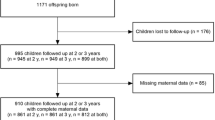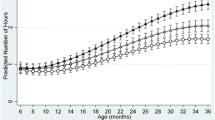Abstract
Purpose
To study the association between television-watching in the earlier years of life and subsequent parents’ concerns about decreased visual acuity in their elementary school-aged child.
Study design
Population-based longitudinal cohort.
Methods
Television-watching and its daily duration, as the main exposure, and parents’ concerns for their child’s decreased visual acuity during the school years, as the main outcome, were picked up from yearly questionnaires performed for the Longitudinal Survey of Newborns in the Twenty-First Century involving all babies born in Japan during either of two periods: between January 10 and 17, 2001 or between July 10 and 17, 2001 (N = 47,015).
Results
Television-/video-watching as the main form of play of children at the ages of 1.5 years and 2.5 years was significantly associated with parents’ concerns for their child’s decreased visual acuity raised once or more in six surveys conducted between the ages of 7 and 12 years (odds ratio, 1.1 and 1.09; 95% CI 1.05–1.15 and 1.04–1.14, respectively). The association remained significant after adjustment for confounding variables, including child’s sex, preterm birth, multiple birth, mother’s age at delivery, mother’s and father’s education, and residential area. Longer daily duration of television-watching at 2.5 years was significantly associated with concerns for the child’s decreased visual acuity between the ages of 7 and 12 years, but not at the ages of 3.5, 4.5, and 5.5 years. The association remained significant in a sensitivity analysis of 28,820 children who participated in all six surveys.
Conclusions
Longer daily exposure to television in children in the earlier years of life was associated with parents’ subsequent concerns about decreased visual acuity in their elementary school-aged child.
Similar content being viewed by others
References
Matsuo T, Matsuo C, Matsuoka H, Kio K. Detection of strabismus and amblyopia in 1.5- and 3-year-old children by a preschool vision-screening program in Japan. Acta Med Okayama. 2007;61:9–16.
Matsuo T, Matsuo C, Kio K, Ichiba N, Matsuoka H. Is refraction with a hand-held autorefractometer useful in addition to visual acuity testing and questionnaires in preschool vision screening at 3.5 years in Japan? Acta Med Okayama. 2009;63:195–202.
Matsuo T, Matsuo C. The prevalence of strabismus and amblyopia in Japanese elementary school children. Ophthalmic Epidemiol. 2005;12:31–6.
Matsuo T, Matsuo C. Comparison of prevalence rates of strabismus and amblyopia in Japanese elementary school children between the years 2003 and 2005. Acta Med Okayama. 2007;61:329–34.
Mistry KB, Minkovitz CS, Strobino DM, Borzekowski DLG. Children’s television exposure and behavioral and social outcomes at 5.5 years: does timing of exposure matter? Pediatrics. 2007;120:762–9.
Sundus M. The impact of using gadgets on children. J Depress Anxiety. 2018;7:1000296.
Lee HS, Park SW, Heo H. Acute acquired comitant esotropia related to excessive Smartphone use. BMC Ophthalmol. 2016;16:37.
Mehta A, Greensher JE, Dahl GJ, Miller KE. Acute onset esotropia from excessive Smartphone use in a teenager. J Pediatr Ophthalmol Strabismus. 2018;55:e42–4.
Longitudinal Survey of Newborns in the 21st Century (2001 Cohort). Household Statistics Office. Ministry of Health, Labor and Welfare. Government of Japan. https://www.mhlw.go.jp/english/database/db-hw/vs03.html. Accessed 27 Aug 2019.
Inoue S, Yorifuji T, Kato T, Sanada S, Doi H, Kawachi I. Children’s media use and self-regulation behavior: longitudinal associations in a nationwide Japanese study. Matern Child Health J. 2016;20:2084–99.
Kato T, Yorifuji T, Inoue S, Yamakawa M, Doi H, Kawachi I. Assocations of preterm births with child health and development: Japanese population-based study. J Pediatr. 2013;163:1578–84.
Diez MH, Yorifuji T, Kado Y, Sanada S, Doi H. Preterm birth and behavioral outcomes at 8 years of age: a nationwide survey in Japan. Arch Dis Child. 2016;101:338–43.
Tamai K, Yorifuji T, Takeuchi A, Nakamura M, Washio Y, Tsukahara H, et al. Associations of gestational age with child health and neurodevelopment among twins: a nationwide Japanese population-based study. Early Hum Dev. 2019;128:41–7.
Yorifuji T, Tsukahara H, Doi H. Early childhood exposure to maternal smoking and Kawasaki disease: a longitudinal survey in Japan. Sci Total Environ. 2019;655:141–6.
Kato T, Yorifuji T, Yamakawa M, Inoue S, Doi H, Eboshida A, et al. Association of maternal age with child health: a Japanese longitudinal study. PLoS ONE. 2017;12:e0172544.
Holden BA, Fricke TR, Wilson DA, Jong M, Naidoo KS, Sankaridurg P, et al. Global prevalence of myopia and high myopia and temporal trends from 2000 through 2050. Ophthalmology. 2016;123:1036–42.
Ding BY, Shih YF, Lin LLK, Hsiao CK, Wang IJ. Myopia among schoolchildren in East Asia and Singapore. Surv Ophthalmol. 2017;62:677–97.
Foster PJ, Jiang Y. Epidemiology of myopia. Eye. 2014;28:202–8.
Morgan IG, French AN, Ashby RS, Guo X, Ding X, He M, et al. The epidemics of myopia: etiology and prevention. Prog Retin Eye Res. 2018;62:134–49.
Huang HM, Chang DS, Wu PC. The association between near work activities and myopia in children: a systematic review and meta-analysis. PLoS ONE. 2015;10:e0140419.
Ku PW, Steptoe A, Lai YJ, Hu HY, Chu D, Yen YF, et al. The associations between near visual activity and incident myopia in children: a nationwide 4-year follow-up study. Ophthalmology. 2019;126:214–20.
Daw NW. Critical periods and amblyopia. Arch Ophthalmol. 1998;116:502–5.
Guan H, Yu NN, Wang H, Boswell M, Shi Y, Rozelle S, et al. Impact of various types of near work and time spent outdoors at different times of day on visual acuity and refractive error among Chinese school-going children. PLoS ONE. 2019;14:e0215827.
Szklo M, Nieto FJ. 5.5.6 Statistical significance in assessing confounding. In: Szklo M, Nieto FJ, editors. Epidemiology beyond the basics. 4th ed. Burlington: Jones & Bartlett Learning; 2019. p. 199–200.
Acknowledgements
We are grateful to Ms. Saori Irie for her technical support.
Author information
Authors and Affiliations
Corresponding author
Ethics declarations
Conflicts of interest
T. Matsuo, None; T. Yorifuji, None.
Additional information
Publisher's Note
Springer Nature remains neutral with regard to jurisdictional claims in published maps and institutional affiliations.
Corresponding Author: Toshihiko Matsuo
About this article
Cite this article
Matsuo, T., Yorifuji, T. Television-watching in the early years of life and the association with parents’ concerns about decreased visual acuity in their elementary school-aged child: results of a nationwide population-based longitudinal survey of Japan. Jpn J Ophthalmol 65, 561–568 (2021). https://doi.org/10.1007/s10384-021-00831-x
Received:
Accepted:
Published:
Issue Date:
DOI: https://doi.org/10.1007/s10384-021-00831-x




